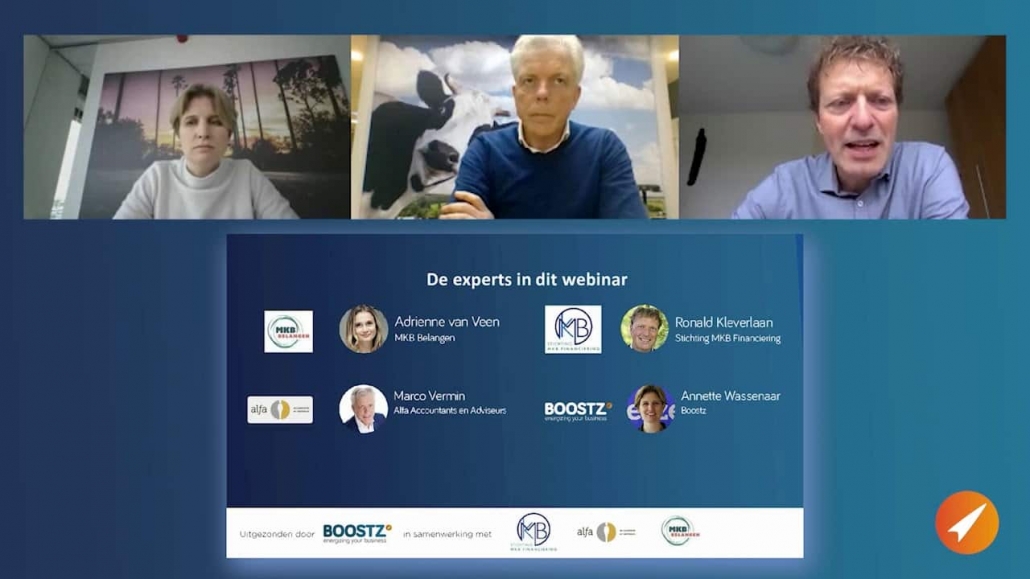Coronavirus Webinar | Supporting SMEs and Self-employed Entrepreneurs
Coronavirus’ impacts on economy
The Coronavirus (COVID-19) crisis has caused lockdown in numerous European countries, which has a major impact on the economy and business continuity of many entrepreneurs. On 17th Mar. 2020, the Dutch government came up with the aid package and various measures to support the economy.

Coronavirus webinar: The support package for entrepreneurs and SMEs
Webinar contents and participants
More than 450 participants logged in last week and asked questions during the Boostz “Coronavirus webinar: The support package for entrepreneurs.” For whom this webinar via the socials has missed the repetition. This webinar was created by Boostz (Annette Wassenaar) and was in collaboration with Adrienne van Veen (MKB Belangen), Marco Vermin (Alfa Accountants en Adviseurs) and Ronald Kleverlaan (Stichting MKB Financiering). Two PDFs were distributed during the webinar to quickly get your financing and liquidity of your company in order during this phase of the Corona crisis. You can download the two PDFs below.
In this webinar, Stichting MKB Financiering (Foundation for SMEs Financing) and Rijksdienst voor Ondernemend Nederland (Netherlands Enterprise Agency) answered questions from entrepreneurs about:
- Support package for SMEs and self-employed entrepreneurs
- Broadening of guarantee credits
- Possibilities for (temporary) financing / credits related to Corona crisis
- Tips to avoid liquidity problems
- Short-time working scheme
- Tax deferral
- And more…
12 Tips on liquidity problems for SMEs
The Corona crisis is now beginning to hit the economy hard. Entrepreneurs in many sectors face acute liquidity problems. Stichting MKB Financiering and ONL voor Ondernemers have jointly created a checklist for self-employed and SME entrepreneurs with 12 tips for limiting liquidity problems and some concrete tips for obtaining additional financing and liquidity in the short term.
- Adjusted cashflow forecasting: Although the impact is still difficult to estimate, it is important to make a realistic estimate. List expected income and expenses for the next twelve months. A solid look into the future makes any bottlenecks quickly visible and allows you to anticipate them.
- Early payment discount: If you are dependent on a few large, regular customers, it may be worth giving them a discount if you pay quickly. Agree with your customers that they will receive a discount on invoices that are paid within a convenient period for you. This is an expensive solution, but it can provide more predictability and earlier payment.
- Periodic billing: For long-term projects, you may be able to agree on a monthly or periodic invoice. Even if the company in question has a long payment term, you will still receive a monthly amount after the first two months. This can be more favorable for long-term projects than a part in advance and a part on completion.
- Down payments: Clients who prefer not to pay monthly for long-term projects – because this is more administrative work – may be willing to work with a down payment. Prior to the work, you send an invoice for, for example, 30 percent of the total amount. This immediately gives you more financial space. The remaining amount will be invoiced after delivery.
- Accounts Receivable: Do not wait to redeem your invoices until they have expired. If there is a problem with an invoice, you do not want to find out until the payment has already been delayed. Call before due date to check that the invoice has arrived and that it is correct according to the customer. You can then solve any problems before the invoice expires and thus remove all objections that prevent timely payment.
- Inventory management: Stockholding companies can achieve their greatest advantage here. Keeps less stock. Make arrangements with suppliers for fast delivery. Entrepreneurs do not like “No selling”. But be realistic: is it really that bad if you can never deliver directly?
- PO numbers: Many large companies work with PO numbers (purchase numbers). If you have just finished a project, it is not pleasant to have to wait another two weeks for a PO number, and then have to wait another sixty or ninety days for payment. Request a PO number well before completion of the assignment. Or even better: prior to the assignment. It does not matter whether you work with a payment in one go, down payments or periodic invoices. Sometimes it is possible to get one PO number for each invoice.
- Make use of the Assistance for the self-employed (BBZ) scheme: Self-employed persons cannot benefit from the short-time working scheme. The BBZ scheme offers a solution for the lost income of self-employed professionals. This can be requested from the municipality where a self-employed person is registered. Support for this is provided by Stichting 155 Help a company.
- Call the Chamber of Commerce’s established advisory team: The government has set up a special advisory team at the Chamber of Commerce to answer all questions from entrepreneurs regarding the corona virus. Here you can be referred as an entrepreneur to other organizations to be helped with the economic consequences of the corona virus. They can be reached on 0800-2117.
- Work with forward financing (factoring): Can’t your company afford to wait a long time for money, for example, because of the corona crisis, you have acutely less income and staff costs that have to be paid every month? Then forward financing or factoring is a wise choice. With pre-financing, all your invoices are partially or fully advanced within 24 hours after being sent. When the invoice is finally paid by your customer, the remaining part will follow. In this way, you always have access to cash.
- Make use of bridging financing (short-term credit): There are new SMEs who, based on turnover from the account, debit card transactions or reading the administration, can provide loans very quickly with a limited term (6-24 months). This can be an ideal way to quickly create liquidity.
- Structural working capital financing: Working capital financing is a logical source of financing for many companies. Not only banks, but also the new nenders (including crowdfunding platforms) offer targeted opportunities to finance working capital.
For more detailed information and financing providers, download the Corona-liquidity checklist here (in Dutch).
Deeper insights into cashflow forecasting: The liquidity planning
Many entrepreneurs have ended up in a completely different situation within a few days, causing turnover to disappear from one moment to the next. The government has announced that it will quickly take appropriate measures. Instead, entrepreneurs can take immediate actions now. In this blog, Stichting MKB Financiering provides a more elaborated plan of cashflow forecasting for SMEs and self-employed entrepreneurs.
For more detailed information, download the Blog 42: When the music stops here (in Dutch).









